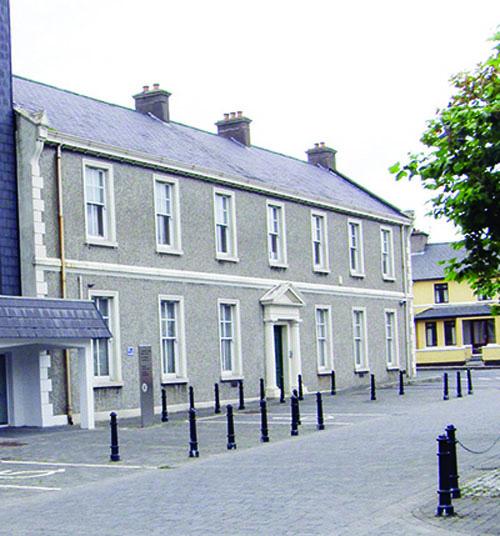Almost four years since the Members of Donegal County Council raised concerns over lack of space in the debating chamber in Lifford, one of proposals put forward by executive officials is the construction of a new headquarters.
The Tirconail Tribune reports that executive officials have briefed councillors on three possible options but no estimates of have yet been given.
The preliminary proposals have led to raised eyebrows among some members who say the local authority’s finances are inadequate to consider any further borrowing for any large-scale internal project at a time when the Council’s commercial ratepayers are struggling to survive.
In recent years the Auditor General has been highlighting his concerns over the Council’s loans and levels of debt incurred.
Other options put to Members include a revamped and enlargement of the existing County House and the full utilisation of all local authority property in the town of Lifford.
The Council owns the former army barracks in Lifford and the matter was addressed in their Budget meeting’s three-year capital budget for 2016-2018.
The proposal put forward in their book of estimates in November 2015 said: “The conclusion of a design concept and initiation of a work Programme to complete a new Council Chamber will take place in 2016, in addition to the fitting out of the former Lifford Army Barracks for office accommodation.”
However Cllrs. say that in the meantime they have not been informed of what progress has been made on these developments.
The issue of lack of space was originally raised by the Members during a meeting in July 2103 with the local elections on the horizon and a need to accommodate eight new Cllrs. in the Lifford Chamber.
In previous times the chamber has undergone a number of facelifts amid strong criticisms at the time that the oak paneling on the walls had been ripped out destroying the acoustics and removing the character of the original room.
Since the 2014 elections, the meetings have taking place every two months in the building’s training room along with the annual Budget meeting.
And while new proposals have been put forward to resolve the issue, Cllrs. have not been provided with an estimate for any of the three proposals outlined.
But given the Council’s financial situation and liabilities, Cllrs are wary of spending any large amount of money on a new building given that the outlay will most likely add to their existing borrowings and a deficit of €14.35 million.
A report from the Auditor General last July highlighted the Council’s deficit at €14.5 million while at the same time they had loans of €135 million: including €62.8 million of borrowings for assets which will have to be funded from the revenue budget.
In his report the Local Government’s Principal Auditor told Donegal County Council that its €14.35 million deficit is a serious matter that the Authority must address. In his report to the officials and 37 Cllrs, Mr. Raymond Lavin gave a detailed breakdown of the figures involved which includes loans repayable by the Council of €135 million at the end of last year between mortgage, bridging finance, shared ownership and voluntary housing related borrowings of approximately €64.5m, €7.7million of loans from Irish Water and €62.8million of borrowings for assets, which will have to be funded from the revenue account.
The Auditor also noted that a significant portion of the borrowings for the assets were currently interest only and convert to principal and interest loans in 2016.
“The projected interest and capital repayments will increase financial costs in 2016 by approximately €2.6 million. This will have an adverse effect on the revenue account,” Mr. Lavin said.
In response to the Auditor’s findings, the Council’s Chief Executive Seamus Neely pointed out that loans repayable had reduced from €171m at the end of 2014 to €135m on the 31st December 2015. “Loans repayable at the end of 2015 are €135m and comprise €72.2m which are fully recoupable from external sources and for which no net demand is placed on the Local Authority.
The remaining €62.8million must be funded by the Local Authority” Mr. Neely said.
It is this level of borrowings that has raised concerns, especially about the construction of a new headquarters. It is suggested that regardless of the estimatedcost, the final figure may well be double that amount.
During the Council’s debate in 2013 on lack of space in the Chamber, Cllr. Gerry Crawford said “Since 1899, from the first meeting of Donegal County Council, the meetings have been taking place in Lifford and it’s important that the council chamber remain in the County House.”
He said government should fund any expansion needed to maintain council in the chamber because the increase stems from a government decision. Council staff told him senior staff will offer proposals on addressing the increase at the earliest possible date. “Time is ticking on and this is something they must work on,” Cllr. Crawford said.
“Since 1899 when the first meeting of Donegal County Council, the meetings have been taking place in Lifford and it’s important that the council chamber remain in the County House,” added Crawford.
Donegal County Council was formed under the Local Government (Ireland) Act 1898 and its first meeting was held in 1899. It took over many of the functions of the Grand Jury and the Boards of Guardians. When the Donegal Board of Health and Public Assistance was abolished in 1942 it took over its public health functions too and retained them until the Health Boards were established in the 1970s.
Tags:







